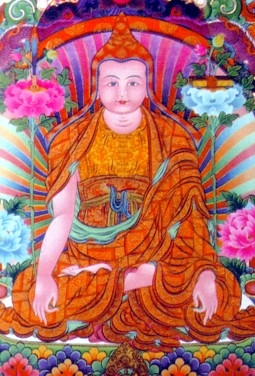Nyingtik Yabshyi: Difference between revisions
mNo edit summary |
mNo edit summary |
||
| Line 1: | Line 1: | ||
[[Image:LongchenRabjam.JPG|frame| | [[Image:LongchenRabjam.JPG|frame|[[Longchen Rabjam]]]] | ||
'''Nyingtik Yabshyi''' ([[Wyl.]] ''snying thig ya bzhi'') literally means the 'Four Parts of the Nyingtik'. It consists of the [[Vima Nyingtik]], [[Lama Yangtik]], [[Khandro Nyingtik]] and [[Khandro Yangtik]]. The Vima Nyingtik and Khandro Nyingtik are known as the 'mother' Nyingtik texts and the Lama Yangtik and Khandro Yangtik are known as 'child' texts, hence another common name for the collection which is the '''Four Mother and Child Sections of Nyingtik''' (Tib. ''nyingtik ma bu shyi''; ''snying thig ma bu zhi''). | '''Nyingtik Yabshyi''' ([[Wyl.]] ''snying thig ya bzhi'') literally means the 'Four Parts of the Nyingtik'. It consists of the [[Vima Nyingtik]], [[Lama Yangtik]], [[Khandro Nyingtik]] and [[Khandro Yangtik]]. The Vima Nyingtik and Khandro Nyingtik are known as the 'mother' Nyingtik texts and the Lama Yangtik and Khandro Yangtik are known as 'child' texts, hence another common name for the collection which is the '''Four Mother and Child Sections of Nyingtik''' (Tib. ''nyingtik ma bu shyi''; ''snying thig ma bu zhi''). | ||
Revision as of 23:14, 10 October 2011

Nyingtik Yabshyi (Wyl. snying thig ya bzhi) literally means the 'Four Parts of the Nyingtik'. It consists of the Vima Nyingtik, Lama Yangtik, Khandro Nyingtik and Khandro Yangtik. The Vima Nyingtik and Khandro Nyingtik are known as the 'mother' Nyingtik texts and the Lama Yangtik and Khandro Yangtik are known as 'child' texts, hence another common name for the collection which is the Four Mother and Child Sections of Nyingtik (Tib. nyingtik ma bu shyi; snying thig ma bu zhi).
Longchen Rabjam also composed the Zabmo Yangtik, which condenses the important pith instructions of both Vima Nyingtik and Khandro Nyingtik.
The Empowerments of Nyingtik Yabshyi
The empowerments have been given many times to the Rigpa sangha, including:
- Kyabjé Dilgo Khyentse Rinpoche, London, 1st July 1987 (Lama Yangtik and Khandro Nyingtik only)
- Kyabjé Penor Rinpoche, London, 11th - 15th November 1988 (all empowerments including Zabmo Yangtik)
- Kyabjé Dilgo Khyentse Rinpoche, Prapoutel, 20th and 21st August 1990 (Khandro Nyingtik only)
- Kyabjé Penor Rinpoche, Lerab Ling, 18th - 21st July 1995 (not including Zabmo Yangtik)
- Kyabjé Trulshik Rinpoche, Lerab Ling, 1st July 2003 (Lama Yangtik only)
- Kyabjé Trulshik Rinpoche, Lerab Ling, 1st - 3rd December 2005 (Lama Yangtik and Khandro Yangtik only)
Alternative Classifications
Dzogchen Pönlop Rinpoche presents two alternative traditions of classifying the Four Parts of the Nyingtik to the primary one presented above, based on the Immaculate Oral Instructions, the Nyingtik teachings of Jamgön Kongtrul:
- A second classification includes
- 1) the Vima Nyingtik;
- 2) the Lama Yangtik;
- 3) the Khandro Nyingtik and Khandro Yangtik, counted as one; and
- 4) the Karma Nyingtik, which comes from the Third Karmapa, Rangjung Dorje.
- A third way of classifying the four, according to the Dzogchen masters Kongpo Dzogchenpa and Rigdzin Tsewang Norbu, includes
- 1) the Vima Nyingtik;
- 2) the Lama Yangtik;
- 3) the Khandro Nyingtik and Khandro Yangtik, counted as one; and
- 4) the Dorsem Nyingtik.[1]
Notes
- ↑ Foreword to Great Perfection: Outer and Inner Preliminaries, by the Third Dzogchen Rinpoche, translated by Cortland Dahl (Ithaca: Snow Lion, 2008), page xi.